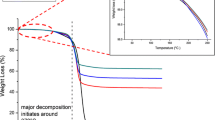Abstract
Dielectric materials with low relative dielectric constants (low-k dielectrics) are needed for electrical insulation to reduce signal propagation delay in microelectronics packaging. This paper reports use of nanoporous alumina of pore size mainly <50 nm and relative dielectric constant 2.0 (measured at frequencies from 100 kHz–2 MHz). Both values are lower than those previously reported. The material is innovatively made by compacting aggregates of submicron particles of fumed alumina. On compaction at 200 kPa, the aggregates are squashed, resulting in mechanical interconnection among the aggregates and formation of a nanostructured sheet with porosity 88%. Because the compacted material is, electrically, equivalent to solid alumina and air in parallel, its relative dielectric constant is 9, that of solid alumina. Reducing the pressure from 200 kPa to 50–100 kPa results in greater porosity (92–93%) and higher relative dielectric constant (2.0–2.3) for the compacted material, in addition to higher relative dielectric constant (13–21) for the solid alumina (because of the increase in the surface capacitance associated with surface charges). For a compaction pressure of 200 kPa, the thermal conductivity of the compacted material is 0.134 W/(m·K) and the upper bound of the thermal conductivity of the solid alumina is 0.94 W/(m·K). The fumed alumina is moldable by compaction.
Similar content being viewed by others
References
S. Ma, Y. Wang, Z. Min, and L. Zhong, Adv. Polym. Technol. 32, 21358/1 (2013).
R. Sasi kumar, M. Ariraman, and M. Alagar, RSC Adv. 4, 19127 (2014).
S. Lazarouk, S. Katsouba, A. Leshok, A. Demianovich, V. Stanovski, S. Voitech, V. Vysotski, and V. Ponomar, Microelectron. Eng. 50, 321 (2000).
S. Lazarouka, S. Katsoubaa, A. Demianovichb, V. Stanovskib, S. Voitech, V. Vysotski, and V. Ponomar, Solid State Electron. 44, 815 (2000).
F. Ito, H. Shobha, M. Tagami, T. Nogami, S. Cohen, Y. Ostrovski, S. Molis, K. Maloney, J. Femiak, and J. Protzman, et al., Microelectron. Eng. 92, 62 (2012).
M.T. Alam, R.A. Pulavarthy, J. Bielefeld, S.W. King, and M.A. Haque, J. Electron. Mater. 43, 746 (2014).
S. Wen and D.D.L. Chung, J. Electron. Packag. 127, 235 (2005).
A. Wang and D.D.L. Chung, Carbon 72, 135 (2014).
P. Somasundaran, Encyclopedia of Surface and Colloid Science, 2nd Edition, Vol. 7 (Boca Raton: CRC Press, 2006), p. 5317.
C. Lin and D.D.L. Chung, J. Mater. Sci. 42, 9245 (2007).
C. Lin and D.D.L. Chung, J. Electron. Mater. 38, 2069 (2009).
B.C. Daly, H.J. Maris, W.K. Ford, G.A. Antonelli, L. Wong, and E. Andideh, J. Appl. Phys. 92, 6005 (2002).
H.T. Vo and F.G. Shi, Microelectron. J. 33, 409 (2002).
http://www.engineeringtoolbox.com/relative-permittivity-d_ 1660.html. Accessed 9 May 2014.
http://en.wikipedia.org/wiki/Aluminium_oxide_(data_page). Accessed 9 May 2014.
W.D. Callister Jr and D.G. Rethwisch, Fundamentals of Materials Science and Engineering, 4th ed. (Hoboken: Wiley, 2012), p. 850.
K.E. Wilkes, R.B. Dinwiddie, and R.S. Graves (eds.), Thermal Conductivity, vol. 23 (Boca Raton: CRC press, 1996), p. 604.
Author information
Authors and Affiliations
Corresponding author
Rights and permissions
About this article
Cite this article
Takizawa, Y., Chung, D.D.L. Fumed-Alumina-Derived Nanoporous Alumina as a New Low-k Dielectric Material for Microelectronics Packaging. J. Electron. Mater. 44, 2211–2220 (2015). https://doi.org/10.1007/s11664-015-3667-y
Received:
Accepted:
Published:
Issue Date:
DOI: https://doi.org/10.1007/s11664-015-3667-y




